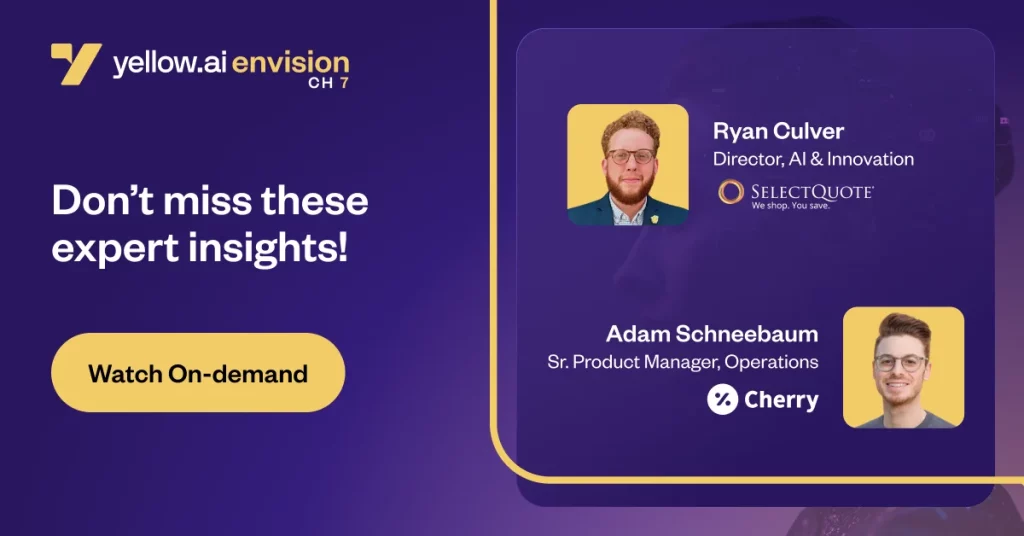The Modern Customer Service Paradox
In almost a decade of crafting AI solutions for CX teams across industries globally, I’ve never seen a more challenging environment than what CX leaders are facing today. In almost all of my conversations with leaders from across the world, I hear about similar frustrations – they are being handed what seems like an impossible task: deliver world-class, personalized service at unprecedented scale while simultaneously dramatically cutting costs.
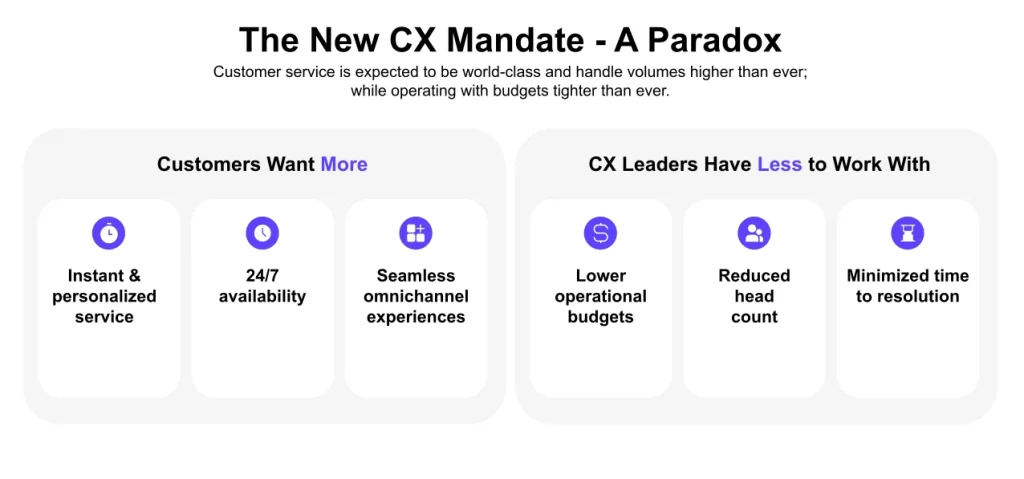
Today CX challenges are just another efficiency problem. It’s two opposing forces creating a fundamental tension that traditional customer service models simply weren’t designed to resolve. And beneath this tension lies a deeper truth:
The way customer service has been designed and structured for decades is increasingly misaligned with what both customers and businesses need in the new reality.
The Limitations of Traditional Service Models
The painful reality is that legacy customer service operations are expensive, inflexible, and increasingly unsustainable:
- A single inbound call costs between $8-15 to handle (Callin.io)
- Staffing 24/7 support can cost $28-38 per representative per hour (Worldwidecallcenters.com)
- The industry faces 30-45% turnover rates (nearly triple the national average) (Nextiva)
- Representatives can only handle one interaction at a time, creating bottlenecks
I’ve watched countless organizations try to solve this equation by applying traditional fixes: training representatives faster, optimizing scripts, adding more self-service options. But these approaches only chip away at the edges of a fundamentally broken model. The root cause runs deeper:
Traditional customer service was architected around minimizing internal costs rather than minimizing customer effort.
This creates a fundamental misalignment that becomes more problematic as customer expectations rise.
Why Legacy Automation Falls Short Today
I often hear executives say, “But we’ve already invested in automation.” or “We have chatbots, IVR systems, and self-service portals.”
However, most pre-generative AI automations were designed with the same internal cost-saving focus as human support systems. They were engineered as digital gatekeepers that prioritized reducing agent workload over resolving customer issues. Rather than creating resolution endpoints, they create deflection points, essentially making customers work harder to reach actual help.
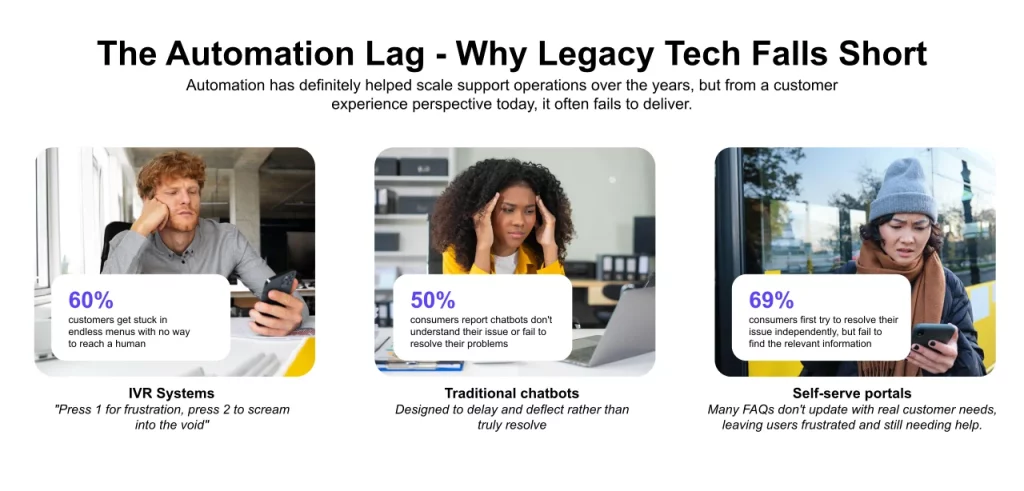
The truth is customers can tell the difference between systems designed to help them and systems designed to deflect them. And they’re getting increasingly fed up with the latter.
The AI Promise: Scaling Excellence Without Compromise
To be honest, not all is wrong with traditional customer service. Every organization has their superstar service reps, those who consistently deliver first-contact resolutions, practice active listening, demonstrate genuine empathy, and maintain composure under pressure and deliver exceptional experiences to the toughest of customer interactions.
The promise of AI isn’t just about cost reduction. It’s about identifying what your best agents do exceptionally well and scaling those capabilities consistently across every interaction while building new capabilities that exceed what humans alone can provide.
This isn’t hypothetical anymore. The technology has matured beyond the point of skepticism, and adoption is accelerating:
- 71.7% of CX professionals have already implemented some form of automation
- 53.8% have automated customer-facing operations
- 45.3% have invested in automating back-end processes
Source: Betting big on AI-first: Insights from customer service leaders
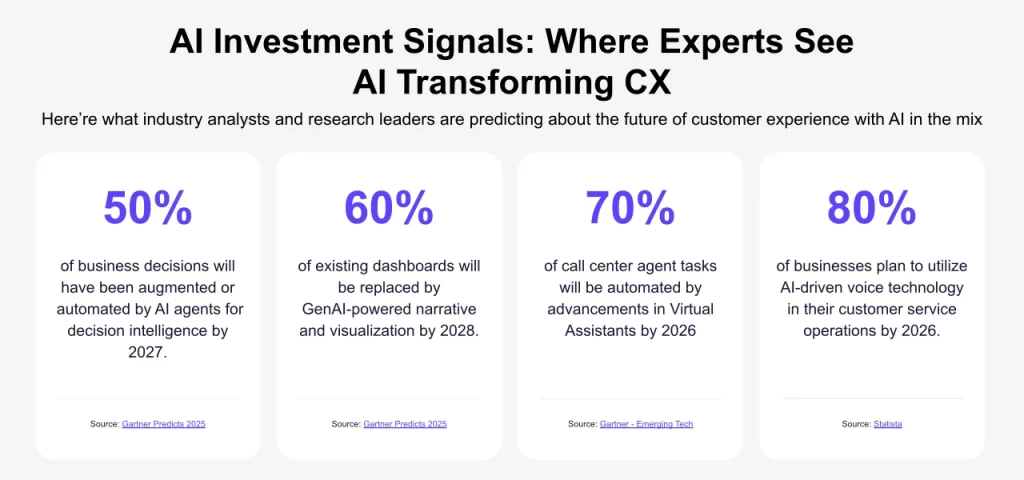
The companies gaining competitive advantage today are those moving from experimental pilots to scaled implementations.
In my conversations with organizations considering AI for customer experience, many are approaching it through the lens of traditional technology adoption – weighing options, running limited pilots, and observing competitors before committing. But this conventional approach fundamentally misunderstands how AI adoption creates value. Unlike previous technologies where benefits scale linearly with implementation, AI operates on an entirely different growth curve that rewards early movers disproportionately.
The Compounding Nature of AI Adoption Maturity
AI implementation doesn’t follow the linear progression of benefits, unlike what we’ve seen with previous technologies. Instead, it operates on a compounding curve where early advantages amplify exponentially over time through three key mechanisms:
- Data Feedback Loops: AI systems learn from every interaction. Organizations with early deployments are already capturing millions of customer data points, refining their models, and creating increasingly sophisticated systems that outperform newer implementations. This data advantage compounds daily and cannot be easily replicated or built overnight.
- Organizational Learning: Successful enterprise AI deployment requires new processes, skills, and organizational structures. Companies implementing now are developing robust knowledgebases about integration, governance, processes and optimization that requires significant time to develop. By the time cautious adopters begin their journey, early movers will have solved challenges that haven’t even surfaced for others.
- Customer Adaptation Curves: Perhaps most critically, moving customers from human-centric service to AI-powered experiences requires careful calibration. The transition demands a dual focus on customer adaptation and knowledge development. Organizations already on this path are methodically shifting expectations, starting with specific use cases while simultaneously building robust knowledge foundations. This involves extracting insights from top agents, refining taxonomies based on actual inquiries, integrating disparate information sources, and implementing feedback loops. This process cannot be compressed without sacrificing quality.
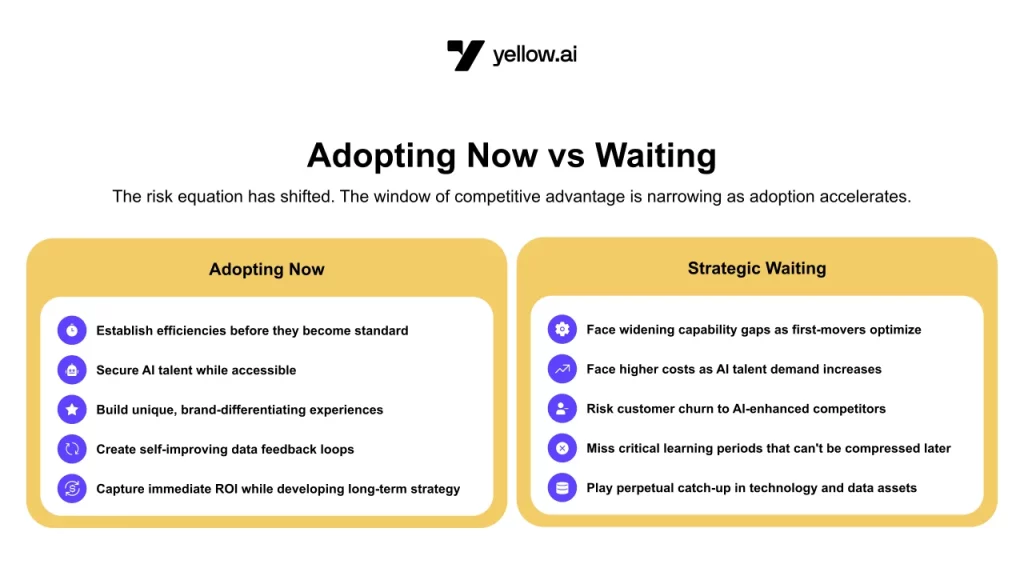
In previous technology cycles, waiting for mature solutions often delivered cost advantages while avoiding early adoption risks. With the state of AI today, this equation has fundamentally inverted.
Companies deploying AI solutions today are already delivering superior experiences at lower costs, creating a financial advantage that allows them to invest more in product development, R&D, and high-value relationship building. This virtuous cycle accelerates their advance while making it progressively more difficult for others to catch up.
Final Thoughts: Overcoming the Impossible Ask
The most successful implementations I’ve observed share common principles:
- Focusing on resolution, not deflection. Designing systems that actually solve customer problems and not just add additional hurdles for customers to get to the resolutions.
- Building experiences centered on minimizing customer effort and making service effortless and delightful rather than just efficient.
The pace at which technology is advancing means each month of delay today is equivalent to a year of waiting in previous technology cycles.
The biggest task here is revealing itself to be less about technical limitations and more about our willingness to fundamentally rethink assumptions that have guided customer service for decades.
In my opinion, organizations that approach this transformation with genuine curiosity about what could be possible with the latest technology at hand, rather than incrementally improving what already exists, will define the next era of customer experience.
And those that find their answers through thoughtful experimentation with rapid iterations will create the new standards against which all others will be measured.
Insights from those who are getting it right
We recently had some really interesting conversations with industry experts and customers about this, at our flagship quarterly thought leadership event Envision. Hear practical insights from those transforming CX with AI and learn how they’re turning these challenges into market advantages.
